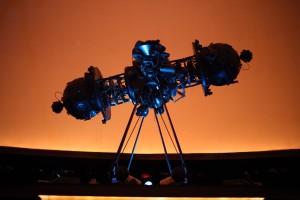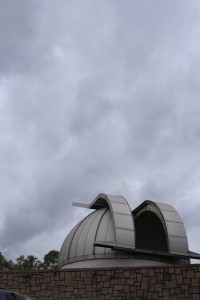
As comes with the territory in city limits, there is pollution in the air. Light is obstructed by the pollution, and it makes it hard to see the clear starry sky. For ones wishing to get a front row seat, Atlanta and Georgia State have the view.
—-

GSU Astronomy Club
For the celestial inclined, Georgia State houses an astronomy club. In the club, students interested in astronomy come to meetings and events.
David Davis, president of the Astronomy Club, shares that being knowledgeable on the mathematics behind astronomy is not necessary to be a member.
“We’re not a club that teaches the fundamentals of astronomy through mathematics, nothing that deep,” Davis said. “What we want to do is have members learn more about planets in our solar system and the constellations they see when they look up at night.”
While being a member of the club does not give enough info to acquire the mind of an astronomer, the club can teach to a novice and share experiences of professional stargazers.
“Our graduate advisors are actual astronomers, and they attend every meeting. They are a wealth of knowledge and are always happy to answer questions or provide clarity on certain aspects of astronomy,” Davis said. “A student can learn more about what it means to be an actual astronomer, and they can learn more about our solar system and the universe we inhabit and just simply have a good time.”
Their regular activities include:
Sun viewing days: The club sets up a solar telescope in Library Plaza, and anyone can come by and take a inner peak into the sun. Sunspots, solar prominences and more are visible.
Observation Nights: One of the telescopes from the Astronomy Department is set up on the roof of the Urban Life Building. Members of the club are able to climb up to look at the constellations or a sky object.
Star Parties: Owned by Georgia State, the club has an overnight camping trip at the Hard Labor Creek Observatory. The organization arrives around 4 p.m. and sets up a barbecue. As night falls, smaller telescopes and the domes are opened.
Monthly Meetings: There are 2 meetings a month. The first is simply a general body meeting. The second meeting, a professor is invited from the Astronomy Department to discuss their research. A yearly spring break trip is also held. This year’s was at the Kennedy Space Center in Florida.
Movie Nights: A sci-fi film is screened. Last semester was the Star Wars Trilogy.
For Davis, distance is what romanticizes the night.
“I love the fact that we can’t fully comprehend the distances, sizes, and temperatures involved in astronomy. Stars and planets are massive and so far away,” Davis said. “We are just now starting to understand how awesome our universe is, and I suppose the vastness and mysteriousness of the universe is attractive. I believe there is life in the universe other than ourselves and to think that we may be looking at a star that hosts a living world is amazing.”
*To join, students can join via Facebook or through OrgSync.
—-
Fernbank Science Center
Utilized most commonly for school field trips, the Fernbank Science Center is a part of the school system and open only to the public on Thursday, Friday and Saturday evenings.
Inside the Center, there is both a planetarium and an observatory at a star fan’s disposal.
The difference between the two can be answered by April Whitt, the astronomer at Fernbank.

The Planetarium
“I guess the best way to describe the difference is what’s ‘real.’ In the planetarium, the audience sits in seats rather like a movie theater, looks up at the domed ceiling, and the presenter uses the Zeiss planetarium projector in the center of the room to project the night sky up on the ceiling,” Whitt said. “It’s like being outside camping, but without bugs, rain or light pollution. There are 500 seats in the planetarium theater, so there is plenty of room for lots of visitors.”
The planetarium hosts a weekly event called, “The Sky Tonight,” that displays the night sky for 30 to 40 minutes, depicting all the stars, planets and constellations. In the viewing, the actual light pollution of the metro Atlanta sky is adjusted to show what the dark skies would look like without it. Questions about it can be directed at the presenter. It is every Saturday morning at 11 a.m. Due to the enclosed and simulated characteristic, it’s open rain or shine.
Other programs are Thursday and Friday evenings at 7 p.m. and 8 p.m. On Saturday, the time slots consist of 11 a.m., noon, 2 p.m. and 3 p.m.

The Observatory
“In the observatory, the weather is the driving factor. If it’s raining or cloudy, the observatory is not open,” Whitt said. “During good weather, visitors line up to look through a large telescope, 36-inch diameter reflector, one at a time, to view a real object in the real sky: the moon, a planet, a nebula or galaxy, maybe, depending on the time of year.”
On a lucky night, besides the moon and the planets, sometimes a comet can go by and in Whitt’s words, it is something “extraordinary.”
The observatory is much smaller in size than the planetarium and requires climbing two flights of stairs up to the roof, which is not temperature controlled. If the weather hinders the telescope’s view, there will be a tour of the observatory where visitors can look at the telescope, but not through it.
The observatory is open every Thursday and Friday, 9 p.m. to 10:30 p.m.
—-
The only limit to the exploration is that Fernbank is a part of the Dekalb County School District and closes at arguably early times. Lately, the observatory’s closure is at 10:30 p.m. The ability to learn is controlled by certain time slots.
Whitt recommends Greg Matloff’s “The Urban Astronomer” for any stargazers looking for tips and ideas inside a light polluted area
“In the planetarium, the presenter can point out a specific constellation or star. In the observatory, if a constellation or star is up in the night sky, it might be visible through the telescope,” Whitt said. “In both places, presenters can answer questions, recommend resources or suggest other places to find information.”
